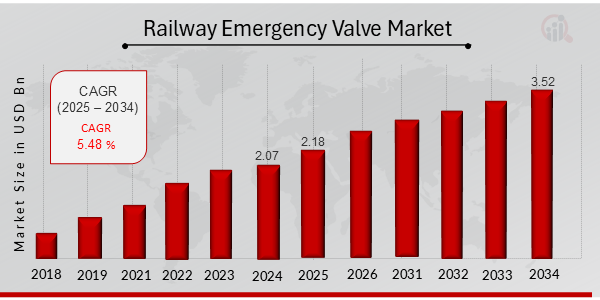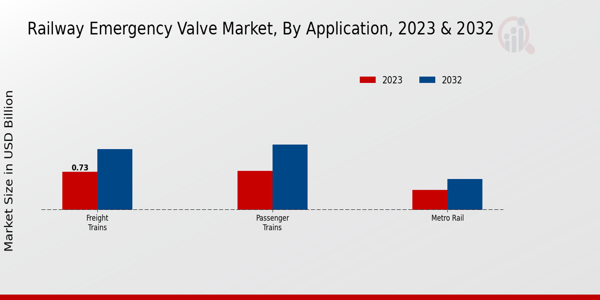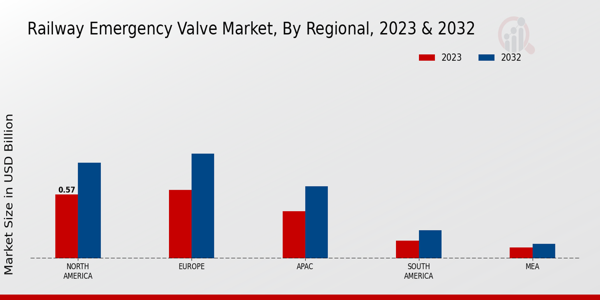Railway Emergency Valve Market Overview
As per MRFR analysis, the Railway Emergency Valve Market Size was estimated at 2.07 (USD Billion) in 2024. The Railway Emergency Valve Market Industry is expected to grow from 2.18 (USD Billion) in 2025 to 3.52 (USD Billion) till 2034, at a CAGR (growth rate) is expected to be around 5.48% during the forecast period (2025 - 2034).
Key Railway Emergency Valve Market Trends Highlighted
The global railway emergency valve market is influenced by several key market drivers, including the growing demand for safety and efficiency in rail transportation. As safety regulations become more stringent, rail companies are increasingly focusing on technologies that enhance operational safety.
This trend fosters the adoption of advanced emergency valve systems, which play a crucial role in preventing accidents and ensuring quick response during emergencies. The need for cost-effective solutions for maintaining aging rail infrastructure further emphasizes the importance of reliable emergency valve systems.
Numerous opportunities can be explored in this market due to ongoing investments in railway infrastructure, particularly in developing regions. Governments are prioritizing the modernization of their rail systems, which presents a chance for companies to offer innovative emergency valve solutions.
Additionally, the shift towards automation in rail operations allows companies to integrate advanced emergency valve technologies designed for automated trains. These developments are likely to open up new avenues for growth and innovation, making it imperative for stakeholders to stay informed about the evolving market landscape.
Recent times have seen significant trends in the market, driven by technological advancements and the increasing focus on sustainability. Innovations such as smart emergency valves equipped with IoT capabilities are gaining traction, enhancing monitoring and control.
Furthermore, the push for environmentally friendly solutions has prompted the industry to explore materials and designs that reduce environmental impact.
As railway operators aim to achieve greener operations, the demand for energy-efficient and low-maintenance emergency valves continues to rise. These trends are reshaping the landscape of the global railway emergency valve market, emphasizing the importance of staying ahead in technology and sustainability.

Source: Primary Research, Secondary Research, MRFR Database and Analyst Review
Railway Emergency Valve Market Drivers
Increasing Safety Regulations and Standards
The global railway emergency valve market is experiencing significant growth driven by increasing safety regulations and standards implemented by governments and organizations worldwide. As railways play a critical role in transportation, ensuring the safety of passengers and goods is paramount.
Regulations require that all railway systems integrate advanced safety mechanisms, including emergency valves, to prevent accidents and hazardous situations. This regulatory push encourages railway operators to invest in modernizing their systems and incorporating state-of-the-art technologies that comply with safety norms.
As a result, the demand for emergency valves in the railway sector continues to rise, especially with governments prioritizing safety in public transport to enhance operational efficiency and mitigate risks. The increasing awareness regarding the importance of safety in the railway sector, especially in densely populated urban areas, is propelling the market for railway emergency valves.
Furthermore, as rail networks evolve and expand, the implementation of emergency systems becomes even more crucial to support the safety of passengers and ensure uninterrupted service. The global railway emergency valve market is expected to witness consistent demand as safety compliance becomes more stringent and railway operators seek to enhance their safety protocols.
Technological Advancements in Valve Design
Technological innovations and advancements in valve design are significant drivers for the global railway emergency valve market.
These developments lead to the manufacturing of more efficient, reliable, and user-friendly emergency valves, promoting their adoption in new railway projects and retrofitting of existing systems. Modern emergency valves now offer enhanced features such as faster response times, improved durability, and greater resistance to wear and tear.
The integration of smart technologies, including IoT capabilities, allows for real-time monitoring and predictive maintenance of valves, further driving their effectiveness and reliability in emergencies.
This trend toward adopting advanced valve technologies positions the global railway emergency valve market for substantial growth as more operators recognize the benefits of investing in next-generation emergency valve systems.
Rising Investments in Rail Infrastructure
The global railway emergency valve market is significantly benefiting from the increased investments in rail infrastructure globally. Governments and private sectors are pouring resources into upgrading and expanding rail networks, recognizing rail transport's effectiveness and efficiency.
This trend is particularly evident in emerging economies, where expanding urban populations drive the need for enhanced transportation solutions. As new railway developments emerge and existing systems get retrofitted, there will be a corresponding rise in the demand for emergency valves to ensure passenger and cargo safety.
The commitment to modernize rail infrastructure not only supports economic development but also emphasizes sustainable transportation, positioning the global railway emergency valve market for exponential growth in the future.
Railway Emergency Valve Market Segment Insights:
Railway Emergency Valve Market Application Insights
The global railway emergency valve market has shown promising growth within its application segment, which encompasses freight trains, passenger trains, and metro rail applications.
The freight trains segment held a significant share, valued at 0.73 USD billion in 2023 and projected to reach 1.16 USD billion by 2032. This dominance can be attributed to the substantial volume of goods transported by freight trains globally, necessitating robust emergency solutions to safeguard both cargo and infrastructure.
In comparison, the passenger trains segment had also carved out a notable position within the market, valued at 0.75 USD billion in 2023 and expected to grow to 1.25 USD billion by 2032. This reflects the increasing focus on passenger safety and the growing investment in modern rail systems, where emergency valves play a critical role in ensuring the well-being of travelers during unforeseen situations.
The metro rail segment, while smaller, contributed to the overall landscape with a valuation of 0.38 USD billion in 2023, anticipated to grow to 0.59 USD billion by 2032. Given the rising urbanization and the demand for efficient public transport systems, metro rail applications are set to gain importance, addressing the urgent need for safety measures in densely populated areas.
Factors driving market growth in the application segment include the ongoing modernization of rail networks and the stringent safety regulations imposed on rail operators. These factors present lucrative opportunities for advancements in emergency valve technologies.
However, challenges such as the high initial investment costs and the need for regular maintenance of emergency systems may hinder rapid adoption across certain regions.
Overall, segmenting the global railway emergency valve market into freight trains, passenger trains, and metro rail applications reveals vital insights into the market dynamics while highlighting growth areas poised for development in alignment with global safety standards and infrastructure investments.
The majority holding of freight trains and passenger trains is indicative of their critical role in logistics and passenger safety, whereas the emerging traction of metro rail is an opportunity that underscores the increasing significance of urban mobility solutions.
By understanding these segments in detail, stakeholders can make informed decisions regarding investment and strategic initiatives within the global railway emergency valve market.

Source: Primary Research, Secondary Research, MRFR Database and Analyst Review
Railway Emergency Valve Market Valve Type Insights
Key to the market growth is the valve type segmentation, which encompasses vital components such as straight valves, angle valves, and check valves. Straight valves are crucial for ensuring direct flow control, while angle valves are essential for directing flow at certain angles, significantly impacting operational efficiency.
Check Valves serve an important function by allowing fluid flow in one direction only, preventing backflow, which is critical for maintaining system integrity. These aspects highlight the importance of each valve type in enhancing safety and reliability within railway operations.
The global railway emergency valve market statistics indicate a noteworthy shift towards these integrated solutions, driven by rising safety regulations and the demand for advanced railway infrastructure.
Furthermore, growth drivers like technological advancements and increased investments in railway modernization are anticipated to bolster the market amidst challenges such as material costs and maintenance requirements. Overall, the segmentation of the global railway emergency valve market is vital for understanding the dynamics that influence market growth and opportunities moving forward.
Railway Emergency Valve Market Material Insights
The global railway emergency valve market for Material is witnessing notable growth, driven by increasing safety regulations and advancements in railway technologies. Within this sector, various materials play a crucial role.
Stainless steel stands out due to its durability and resistance to corrosion, making it essential in high-pressure applications. Brass is valued for its excellent machinability and reliability in sealing applications, contributing significantly to the market landscape.
Plastic materials are gaining traction for their lightweight properties, offering cost-effective solutions while maintaining performance standards. Aluminum is recognized for its strength-to-weight ratio, which is paramount in enhancing overall operational efficiency in railway systems. The market growth is further supported by opportunities in emerging markets that demand innovative railway solutions.
Railway Emergency Valve Market Operating Mechanism Insights
The Operating Mechanism segment plays a crucial role within this market, encompassing various types such as manual, automatic, pneumatic, and hydraulic mechanisms. Each type is essential for safety and efficiency in railway operations; for instance, automatic valves are increasingly preferred for their reliability and speed of response during emergencies.
The demand for hydraulic mechanisms is also on the rise due to their ability to exert greater force with precision, making them vital in high-pressure applications. Furthermore, the market statistics indicate a growing trend toward automation in railway systems, which enhances operational efficiency and safety protocols.
This segment significantly contributes to the overall global railway emergency valve market revenue, driven by technological advancements and the necessity for regulatory compliance in the railway industry. The insights into the global railway emergency valve market segmentation highlight not only the importance of individual operating mechanisms but also the collective need for advancements in railway safety systems, which is critical for market growth and development in the coming years.
Railway Emergency Valve Market Regional Insights
The regional segment of the global railway emergency valve market revenue showcases significant growth across various regions, contributing to the overall market dynamics. In 2023, North America was valued at 0.57 USD billion, dominating the market due to its advanced railway infrastructure and increasing safety regulations.
Europe followed closely with a valuation of 0.61 USD billion, benefiting from stringent safety standards and a robust railway network. The APAC region is noted with a valuation of 0.42 USD billion, reflecting substantial investments in railway safety amid rapid urbanization, although it remains the least dominant in this market.
South America and MEA were valued at 0.16 USD billion and 0.1 USD billion respectively, where growth is more modest due to developing infrastructure, yet they present opportunities for expansion in railway safety solutions.
The global railway emergency valve market data highlights the importance of safety measures in rail transport, propelling market growth in these regions. Overall, North America and Europe played significant roles in market expansion, while APAC shows potential as it continues to modernize its railway systems.

Source: Primary Research, Secondary Research, MRFR Database and Analyst Review
Railway Emergency Valve Market Key Players and Competitive Insights:
The global railway emergency valve market has been experiencing significant growth as safety concerns and regulatory requirements continue to rise in the railway sector. Emergency valves are critical components that ensure the safety and reliability of railway systems, allowing for quick pressure release and system stabilization during emergencies.
As a result, the market has seen increased competition among various manufacturers striving to enhance their product offerings through innovation, better materials, and advanced technology. In this challenging landscape, companies are not only competing on the basis of quality and efficiency but also on customer service, pricing strategies, and technological advancements that can provide added value to their clients.
Market trends indicate a growing emphasis on durability and sustainability as stakeholders seek solutions that minimize environmental impact while maintaining optimal performance standards. Schneider Electric has established a strong foothold in the global railway emergency valve market with its emphasis on innovation and integration of smart technologies.
The company's commitment to developing reliable, efficient emergency valve systems contributes positively to railway safety, drawing attention from both the public and private sectors. Schneider Electric's unique strengths lie in its vast experience in automation and control technologies, enabling it to offer sophisticated solutions tailored to customers' specific needs.
The company's global presence further enhances its competitiveness, allowing it to reach diverse markets and establish partnerships that expand its operational footprint. In addition to product reliability, Schneider Electric emphasizes sustainable practices, providing enhanced efficiency in railway operations while adhering to environmental regulations.
Parker Hannifin similarly presents a formidable presence in the global railway emergency valve market, distinguished by its robust engineering capabilities and commitment to high-performance solutions. Known for its strong engineering heritage, Parker Hannifin excels in designing and manufacturing emergency valves that meet stringent safety standards.
The company boasts a well-diversified product portfolio, allowing it to cater to a wide range of railway applications, thereby attracting numerous clients across different geographies. Parker Hannifin's reputation for quality and reliability is backed by extensive research and development initiatives, enabling them to continually innovate and adapt to market demands.
The company also focuses on delivering integrated solutions that optimize railway system performance, helping clients enhance their operational efficiency while reducing downtime. This multifaceted approach places Parker Hannifin in a competitive position as it continues to address emerging trends and customer needs within the railway sector.
Key Companies in the railway emergency valve market Include:
- Schneider Electric
- Parker Hannifin
- Honeywell
- KnorrBremse
- GE Transportation
- Faiveley Transport
- Mitsubishi Electric
- Eaton
- Bombardier
- Siemens
- Hitachi
- Alstom
- Brookville Equipment Corporation
- Wabtec
- Crane Co
Railway Emergency Valve Market Developments
Recent developments in the global railway emergency valve market have focused on advancements in safety and efficiency. Companies such as Schneider Electric, Honeywell, and KnorrBremse are leading initiatives to improve product reliability in railway systems.
The demand for innovative solutions is propelling investments and collaborations among companies, including an increase in research and development efforts. Siemens and Mitsubishi Electric have been working on integrating smart valve technologies to enhance automation in railway applications.
In terms of mergers and acquisitions, significant activities have taken place, particularly involving Wabtec and Bombardier, highlighting a consolidation trend aimed at expanding product portfolios and geographical reach.
The market has also seen strong growth projections, with various companies, including Eaton and GE Transportation, reporting increased valuations due to rising infrastructure projects and government funding in rail transport.
This growth is influencing broader trends, such as the emphasis on sustainability and eco-friendly solutions, reflecting a shift toward greener technologies in the railway sector, ultimately enhancing the overall competitiveness of the global railway emergency valve market.
Railway Emergency Valve Market Segmentation Insights
Railway Emergency Valve Market Application Outlook
- Freight Trains
- Passenger Trains
- Metro Rail
Railway Emergency Valve Market Valve Type Outlook
- Straight Valve
- Angle Valve
- Check Valve
Railway Emergency Valve Market Material Outlook
- Stainless Steel
- Brass
- Plastic
- Aluminum
Railway Emergency Valve Market Operating Mechanism Outlook
- Manual
- Automatic
- Pneumatic
- Hydraulic
Railway Emergency Valve Market Regional Outlook
- North America
- Europe
- South America
- Asia Pacific
- Middle East and Africa
| Report Attribute/Metric |
Details |
|
Market Size 2024
|
2.07 (USD Billion)
|
|
Market Size 2025
|
2.18 (USD Billion)
|
|
Market Size 2034
|
3.52 (USD Billion)
|
|
Compound Annual Growth Rate (CAGR)
|
5.48% (2025 - 2034)
|
|
Report Coverage
|
Revenue Forecast, Competitive Landscape, Growth Factors, and Trends
|
|
Base Year
|
2024
|
|
Market Forecast Period
|
2025 - 2034
|
|
Historical Data
|
2019 - 2023
|
| Market Forecast Units |
USD billion |
| Key Companies Profiled |
Schneider Electric, Parker Hannifin, Honeywell, KnorrBremse, GE Transportation, Faiveley Transport, Mitsubishi Electric, Eaton, Bombardier, Siemens, Hitachi, Alstom, Brookville Equipment Corporation, Wabtec, Crane Co |
| Segments Covered |
Application, Valve Type, Material, Operating Mechanism, Regional |
| Key Market Opportunities |
Growing rail infrastructure investments, Increasing demand for safety features, Expansion of smart railway systems, Shift towards sustainable transit solutions, Rising urbanization and population growth |
| Key Market Dynamics |
Rising railway safety regulations, Increasing railway infrastructure investment, Growing demand for automation, Technological advancements in valves, Expansion of rail networks in emerging markets |
| Countries Covered |
North America, Europe, APAC, South America, MEA |
Frequently Asked Questions (FAQ) :
The global railway emergency valve market is expected to be valued at 3.52 USD billion in 2034.
The expected CAGR for the global railway emergency valve market from 2025 to 2034 is 5.48%.
The Freight Trains application segment is projected to have a market value of 1.16 USD billion by 2032.
The market size for Passenger Trains is expected to reach 1.25 USD billion in 2032.
The Metro Rail segment is expected to be valued at 0.59 USD billion in 2032.
In 2023, North America held the largest market value at 0.57 USD billion.
Europe's market value is projected to reach 0.93 USD billion by 2032.
The Asia Pacific region is forecasted to have a market size of 0.64 USD billion in 2032.

















